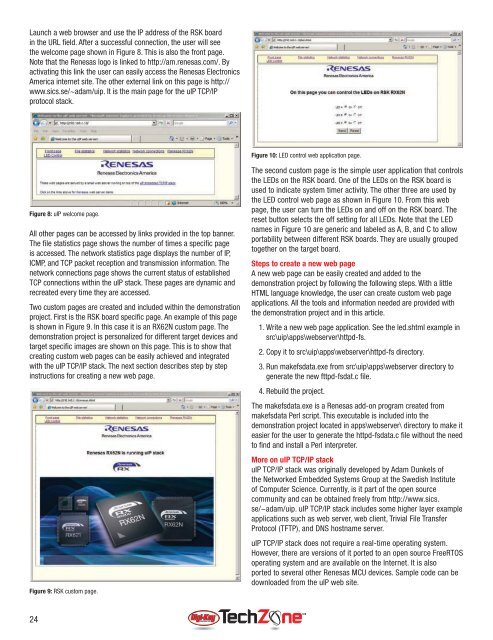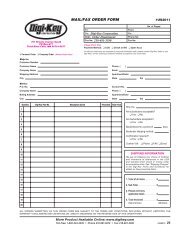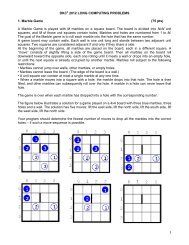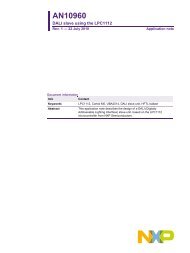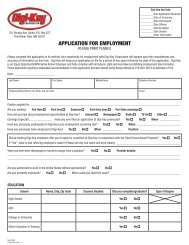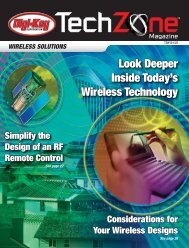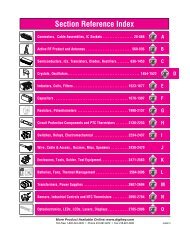Microcontroller Solutions TechZone Magazine, April 2011 - Digikey
Microcontroller Solutions TechZone Magazine, April 2011 - Digikey
Microcontroller Solutions TechZone Magazine, April 2011 - Digikey
Create successful ePaper yourself
Turn your PDF publications into a flip-book with our unique Google optimized e-Paper software.
Launch a web browser and use the IP address of the RSK board<br />
in the URL fi eld. After a successful connection, the user will see<br />
the welcome page shown in Figure 8. This is also the front page.<br />
Note that the Renesas logo is linked to http://am.renesas.com/. By<br />
activating this link the user can easily access the Renesas Electronics<br />
America internet site. The other external link on this page is http://<br />
www.sics.se/~adam/uip. It is the main page for the uIP TCP/IP<br />
protocol stack.<br />
Figure 10: LED control web application page.<br />
Figure 8: uIP welcome page.<br />
All other pages can be accessed by links provided in the top banner.<br />
The fi le statistics page shows the number of times a specifi c page<br />
is accessed. The network statistics page displays the number of IP,<br />
ICMP, and TCP packet reception and transmission information. The<br />
network connections page shows the current status of established<br />
TCP connections within the uIP stack. These pages are dynamic and<br />
recreated every time they are accessed.<br />
Two custom pages are created and included within the demonstration<br />
project. First is the RSK board specifi c page. An example of this page<br />
is shown in Figure 9. In this case it is an RX62N custom page. The<br />
demonstration project is personalized for different target devices and<br />
target specifi c images are shown on this page. This is to show that<br />
creating custom web pages can be easily achieved and integrated<br />
with the uIP TCP/IP stack. The next section describes step by step<br />
instructions for creating a new web page.<br />
Figure 9: RSK custom page.<br />
The second custom page is the simple user application that controls<br />
the LEDs on the RSK board. One of the LEDs on the RSK board is<br />
used to indicate system timer activity. The other three are used by<br />
the LED control web page as shown in Figure 10. From this web<br />
page, the user can turn the LEDs on and off on the RSK board. The<br />
reset button selects the off setting for all LEDs. Note that the LED<br />
names in Figure 10 are generic and labeled as A, B, and C to allow<br />
portability between different RSK boards. They are usually grouped<br />
together on the target board.<br />
Steps to create a new web page<br />
A new web page can be easily created and added to the<br />
demonstration project by following the following steps. With a little<br />
HTML language knowledge, the user can create custom web page<br />
applications. All the tools and information needed are provided with<br />
the demonstration project and in this article.<br />
1. Write a new web page application. See the led.shtml example in<br />
src\uip\apps\webserver\httpd-fs.<br />
2. Copy it to src\uip\apps\webserver\httpd-fs directory.<br />
3. Run makefsdata.exe from src\uip\apps\webserver directory to<br />
generate the new fttpd-fsdat.c fi le.<br />
4. Rebuild the project.<br />
The makefsdata.exe is a Renesas add-on program created from<br />
makefsdata Perl script. This executable is included into the<br />
demonstration project located in apps\webserver\ directory to make it<br />
easier for the user to generate the httpd-fsdata.c fi le without the need<br />
to fi nd and install a Perl interpreter.<br />
More on uIP TCP/IP stack<br />
uIP TCP/IP stack was originally developed by Adam Dunkels of<br />
the Networked Embedded Systems Group at the Swedish Institute<br />
of Computer Science. Currently, is it part of the open source<br />
community and can be obtained freely from http://www.sics.<br />
se/~adam/uip. uIP TCP/IP stack includes some higher layer example<br />
applications such as web server, web client, Trivial File Transfer<br />
Protocol (TFTP), and DNS hostname server.<br />
uIP TCP/IP stack does not require a real-time operating system.<br />
However, there are versions of it ported to an open source FreeRTOS<br />
operating system and are available on the Internet. It is also<br />
ported to several other Renesas MCU devices. Sample code can be<br />
downloaded from the uIP web site.<br />
24


